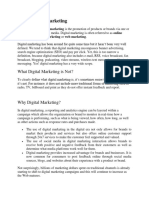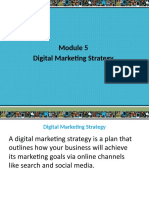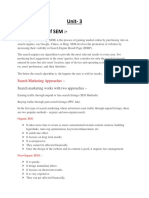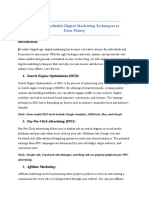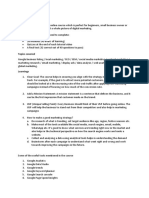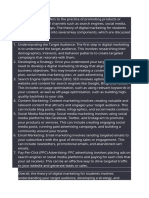Digital Marketing Strategy
Digital Marketing Strategy
Uploaded by
mahawedasreeconstructionsCopyright:
Digital Marketing Strategy
Digital Marketing Strategy
Uploaded by
mahawedasreeconstructionsCopyright
Share this document
Did you find this document useful?
Is this content inappropriate?
Copyright:
Digital Marketing Strategy
Digital Marketing Strategy
Uploaded by
mahawedasreeconstructionsCopyright:
https://digitalithub.
com/
Digital Marketing Strategy
In this topic, you’ll learn how to approach the design and execution of a successful digital
marketing strategy.
What is a digital marketing strategy?
A digital marketing strategy is a detailed plan on how you can utilize the different digital
marketing channels to achieve your business goals.
When you design a digital marketing strategy you need to consider which channels to use,
the resources (people, time, and money) to assign to each channel and what to expect in
terms of results.
A common mistake made by many digital marketing managers or small business owners is
that they try to execute everything at once and at the end of the day they get no results.
This is because they don’t have the necessary expertise to run digital marketing campaigns
or because they end up spending their budgets on channels that are not suitable for their
business.
Example of a Digital Marketing Strategy:
Although each and every digital marketing strategy is unique and based on the specific
needs and goals of a business, you can read below an example to help you understand how
all marketing channels can work towards a common goal.
Example: Digital Marketing Strategy for a company selling digital products (online courses,
ebooks, etc.).
All Rights Reserved to Digital IT Hub Software Solutions https://bootcamps.digitalithub.com/
https://digitalithub.com/
Step 1: Website – The first step is to create a website that is fast and mobile-friendly. The
website should have several landing pages (or sales pages) to present the company and its
products.
Step 2: SEO – The next step is to perform an SEO Audit and identify which areas need to
be optimized for SEO. Technical SEO should be tackled first, then On-Page SEO and last
Off-Page SEO.
Step 3: Content Marketing – Based on the results of thorough keyword research and
findings of the SEO Audit, you should create a content marketing plan that will include:
● What kind of content to create for the website (text and videos)
● When to publish it (publishing calendar)
● How to promote it (can include social media channels, email, and PPC
campaigns).
Step 4: Social Media Marketing – Utilize all social media marketing campaigns to promote
brand awareness and sales. Identify which social media channels are suitable for marketing
your business (based on customer profiling) and create a schedule for publishing content on
those networks.
At the same time, start creating lists of influencers and other people that are most likely to be
interested in your products or share your content on social media.
All Rights Reserved to Digital IT Hub Software Solutions https://bootcamps.digitalithub.com/
https://digitalithub.com/
Step 5: Email Marketing – Start building an email list using several CTA areas on your
website and social media channels.
Your initial goal is to get people to sign up for your newsletter or register to download free
material or register for free trials.
Create several email marketing funnels to get ‘push’ your subscribers from the awareness
stage to the conversion stage.
Step 6: Pay-Per-Click Advertising – In parallel to the above activities set up a Google Ads
Campaign to target people searching for product-related keywords on Google and
remarketing campaigns on Facebook to go after users that visited your website but did not
convert.
Step 7: Video Marketing – Part of step 3 above is to identify which topics/keywords you can
create video content. Publish your videos on a dedicated YouTube channel, on Facebook,
Instagram and any other platforms you are targeting in your campaigns.
For each video create a blog post on your website and embed the video with text content.
Step 8: Mobile Marketing – Consider creating a mobile app that users can download from
the App Stores that will include your latest news and ways for people to access your courses
through your app.
Step 9: Measure and Analyze the results – Ensure that you have Google analytics
installed and configured correctly and that you can accurately measure the effectiveness of
the above campaigns.
All Rights Reserved to Digital IT Hub Software Solutions https://bootcamps.digitalithub.com/
https://digitalithub.com/
Create an excel sheet and add for each campaign details about the cost, number of visits,
number of conversions, people reached, etc.
The above it’s just a summary of what your digital marketing strategy should include. If you
are a small business with limited resources then it’s normal that you won’t be able to execute
the whole plan from the very beginning.
What you should do is to follow a step-by-step approach starting with your website, SEO and
content marketing. Once you manage to have these in place for a number of months, you
will gradually experience an increase in traffic and revenue and then you can add the other
tools to the mix.
KEY LEARNINGS
Your digital marketing strategy is a series of actions that help you achieve your business
goals through carefully selected online marketing channels. These channels include paid,
earned, and owned media, and can all support a common campaign around a particular line
of business.
Running a full-blown digital marketing campaign will require a lot of effort, time and
resources. The best way is to follow a step by step approach. Start with the channels that
are most important to your business, run profitable campaigns and then move on to other
channels.
The Digital Marketing Checklist topic will give you a good idea of ALL the tasks you need to
execute and you can use that as your digital marketing template.
All Rights Reserved to Digital IT Hub Software Solutions https://bootcamps.digitalithub.com/
You might also like
- Digital Marketing Checklist PDFDocument12 pagesDigital Marketing Checklist PDFSHAILESH PURANIK100% (10)
- Digital Marketing in 2023. A Quickstart Guide (Martin Pidsley) (Z-Library)Document101 pagesDigital Marketing in 2023. A Quickstart Guide (Martin Pidsley) (Z-Library)Vlad Vodanovici85% (20)
- Digital Marketing StrategyDocument9 pagesDigital Marketing Strategyandrew75% (4)
- CS Oh My EnglishDocument3 pagesCS Oh My EnglishenesusNo ratings yet
- Digital MarketingDocument9 pagesDigital Marketingprasad shevateNo ratings yet
- Review For Fundamentals of Digital MarketingDocument6 pagesReview For Fundamentals of Digital Marketingcerebrum creationNo ratings yet
- Digital Marketin1 Materials AlexDocument10 pagesDigital Marketin1 Materials AlexTEGEGN TEKALIGNNo ratings yet
- Digital Marketing BegningDocument9 pagesDigital Marketing BegningRomi KhanNo ratings yet
- Digital Marketing 1Document22 pagesDigital Marketing 1vaishnaviNo ratings yet
- Digital Marketing 1Document22 pagesDigital Marketing 1vaishnaviNo ratings yet
- 14Document3 pages14herrajohnNo ratings yet
- G2 AdvertiDocument4 pagesG2 AdvertiNisa GonzalesNo ratings yet
- Guide Digital Marketing Plan - Katherine Pisciotti PDFDocument6 pagesGuide Digital Marketing Plan - Katherine Pisciotti PDFDiego MendivilNo ratings yet
- A Step by Step GuideDocument8 pagesA Step by Step GuideM. HasanNo ratings yet
- Nidm Course of Digital MarketingDocument5 pagesNidm Course of Digital MarketingmanojNo ratings yet
- Digital MarketingDocument12 pagesDigital MarketingAhmed MostafaNo ratings yet
- Digital Marketing Unit 1Document12 pagesDigital Marketing Unit 1kriti PhogaatNo ratings yet
- The Ultimate Guide To Digital Marketing: Strategies and Tactics for SuccessFrom EverandThe Ultimate Guide To Digital Marketing: Strategies and Tactics for SuccessNo ratings yet
- What Does A Digital Marketer DoDocument5 pagesWhat Does A Digital Marketer DoLearning new thingNo ratings yet
- Module 5 E Comm Internet MarketingDocument25 pagesModule 5 E Comm Internet MarketingJoshua BarracaNo ratings yet
- Curs 7Document75 pagesCurs 7Milena MargaritNo ratings yet
- Syllabus of Digital MarketingDocument3 pagesSyllabus of Digital MarketingdamodarNo ratings yet
- University Institute of Computing Bachelor of Computer ApplicationDocument14 pagesUniversity Institute of Computing Bachelor of Computer ApplicationAnuj UpadhyayaNo ratings yet
- Digital Marketing MBA IIDocument4 pagesDigital Marketing MBA IISonam NasreenNo ratings yet
- How To Sell Software To CompaniesDocument16 pagesHow To Sell Software To CompaniesQuang Huy NguyenNo ratings yet
- The Complete Digital Marketing Guide (PDF)Document21 pagesThe Complete Digital Marketing Guide (PDF)chennai oneNo ratings yet
- Practical 5: Identify The Business Opportunity Suitable For You. Digital Marketing: A Right Business For Youngster'sDocument5 pagesPractical 5: Identify The Business Opportunity Suitable For You. Digital Marketing: A Right Business For Youngster's02 - CM Ankita AdamNo ratings yet
- Estrategias de Marketing DigitalDocument26 pagesEstrategias de Marketing DigitalJavier PereyraNo ratings yet
- Digital Marketing and E CommerceDocument15 pagesDigital Marketing and E CommerceshivahellistrikerNo ratings yet
- Digital Marketing NotesDocument92 pagesDigital Marketing Notesadithg16No ratings yet
- Digital MarketingDocument23 pagesDigital Marketingfatouby74No ratings yet
- Unit 1Document88 pagesUnit 1Neha SharmaNo ratings yet
- UntitledDocument7 pagesUntitledPriyanshu SoniNo ratings yet
- Upskill DigitalmarketingDocument7 pagesUpskill Digitalmarketingupskill indiaNo ratings yet
- Unit 3 MbaDocument11 pagesUnit 3 MbaMiyonNo ratings yet
- DeAsra - Digital Marketing ManualDocument9 pagesDeAsra - Digital Marketing ManualSreeram KNo ratings yet
- Digital MarketingDocument38 pagesDigital Marketingbuntyyoyo5No ratings yet
- Week 7 - 11 Business Implementation & Marketing Plan, Product Pricing Trategies, Promotion.Document42 pagesWeek 7 - 11 Business Implementation & Marketing Plan, Product Pricing Trategies, Promotion.castillojosephrayNo ratings yet
- Digital Marketing UNIT-IIDocument15 pagesDigital Marketing UNIT-IIvishalap775No ratings yet
- Easy and Profitable Digital Marketing Techniques To Earn MoneyDocument2 pagesEasy and Profitable Digital Marketing Techniques To Earn MoneyMuhammed MughniNo ratings yet
- The Digital Marketing Playbook: Proven Strategies for Online SuccessFrom EverandThe Digital Marketing Playbook: Proven Strategies for Online SuccessNo ratings yet
- DM Unit-4Document51 pagesDM Unit-4shubham waliaNo ratings yet
- ReadDocument2 pagesReadGaneashaNo ratings yet
- Unit 2 Social Media Marketing FinalDocument63 pagesUnit 2 Social Media Marketing FinaltwitterkatoolkitNo ratings yet
- Digital Marketing Notes 1Document60 pagesDigital Marketing Notes 1xefoke4965No ratings yet
- Marketing Strategy Vs TacticsDocument4 pagesMarketing Strategy Vs Tacticsjuan marn sanzNo ratings yet
- 5 Digital Marketing Strategies For Your Business: SEO (Search Engine Optimization)Document2 pages5 Digital Marketing Strategies For Your Business: SEO (Search Engine Optimization)rashida afzalNo ratings yet
- Lead MagnetDocument28 pagesLead MagnetNamitha cNo ratings yet
- Digital Advertising WorkbookDocument34 pagesDigital Advertising WorkbookABDELGHANINo ratings yet
- Emerging Trends of Digital Marketing PDFDocument9 pagesEmerging Trends of Digital Marketing PDFSiddharth soniNo ratings yet
- Assignment E-MarketingDocument16 pagesAssignment E-MarketingProshun BiproNo ratings yet
- Digital Marketing Plan Template v1Document18 pagesDigital Marketing Plan Template v1mahmoud.mukmin596750% (2)
- Digital Marketing by ChatgpxDocument2 pagesDigital Marketing by ChatgpxEdri FauzanNo ratings yet
- DigitalDocument43 pagesDigitalSATYAM KUMAR DEYNo ratings yet
- Plan de Marketing Digital Feb - 14 - 2023Document9 pagesPlan de Marketing Digital Feb - 14 - 2023Fernando RoneyNo ratings yet
- Digital Marketing Part 2 FinalDocument42 pagesDigital Marketing Part 2 Finaltarek.sayd.23d983No ratings yet
- Pricing Strategy-PositioningDocument3 pagesPricing Strategy-PositioningAnurag SharmaNo ratings yet
- Introduction To Digital MarketingDocument45 pagesIntroduction To Digital MarketingSATYAM KUMAR DEYNo ratings yet
- Unit 1Document12 pagesUnit 1CS0126 VINAY KUMARNo ratings yet
- The Who, What, Why, & How of Digital MarketingDocument8 pagesThe Who, What, Why, & How of Digital MarketingZarish Azhar100% (1)
- SQEMS Digest April 2022Document100 pagesSQEMS Digest April 2022Jan Raver SevaNo ratings yet
- The Top 3 Benefits of SASE: and How To Achieve ThemDocument5 pagesThe Top 3 Benefits of SASE: and How To Achieve ThemPrasad KshirsagarNo ratings yet
- English Grammar. Lindley Murray. 1809Document349 pagesEnglish Grammar. Lindley Murray. 1809Álvaro de Souza0% (1)
- CBSE Class 10 Foundation of Information Technology SET 4 Compartment Annual Question Paper 2018 PDFDocument4 pagesCBSE Class 10 Foundation of Information Technology SET 4 Compartment Annual Question Paper 2018 PDFashishiet100% (1)
- Wordpress CourseDocument9 pagesWordpress CourseCristian CiucanuNo ratings yet
- Free Open Source VPN Clients, SolutionsDocument7 pagesFree Open Source VPN Clients, Solutions--No ratings yet
- Digital Marketing Agency PitampuraDocument3 pagesDigital Marketing Agency PitampurapankajkumarseoagencyNo ratings yet
- IWP Lab ManualDocument28 pagesIWP Lab ManualChester LaneNo ratings yet
- Chapter 8 - Safety and SecurityDocument31 pagesChapter 8 - Safety and SecuritySoo Ke Xin100% (1)
- Regional Cooperation On Cyber Security: A Deemed NecessityDocument8 pagesRegional Cooperation On Cyber Security: A Deemed NecessityAnupam TiwariNo ratings yet
- nGeniusPULSE v3 - 6 Release NotesDocument4 pagesnGeniusPULSE v3 - 6 Release Notesmodather nadyNo ratings yet
- Mostpopularusafacebookgroupslist2024-TechEduByte 1725900501309Document15 pagesMostpopularusafacebookgroupslist2024-TechEduByte 1725900501309saloj2580No ratings yet
- AmfDocument5 pagesAmfHabeeb MustafaNo ratings yet
- Installation RadManDocument14 pagesInstallation RadManPujun AceNo ratings yet
- 2021 - AUA - Metrobank For Confirmed ResourceDocument3 pages2021 - AUA - Metrobank For Confirmed ResourceJay-arr LumogdangNo ratings yet
- Outlines of Logic Friedrich Adolf Trendelenburg PDFDocument41 pagesOutlines of Logic Friedrich Adolf Trendelenburg PDFNiccolo CobradoNo ratings yet
- Semrush-Site Audit Issues-Mobiledokkan-19th May 2023Document9 pagesSemrush-Site Audit Issues-Mobiledokkan-19th May 2023sohag gamingNo ratings yet
- Introduction To Microsoft Enterprise Mobility + Security: Antonio MaioDocument26 pagesIntroduction To Microsoft Enterprise Mobility + Security: Antonio MaioAli DaherNo ratings yet
- Security Vendors For OEMDocument8 pagesSecurity Vendors For OEMRameshNo ratings yet
- Test2 - Google SearchDocument3 pagesTest2 - Google SearchoglasifwdNo ratings yet
- Cyber Unit4 Lecture 5Document8 pagesCyber Unit4 Lecture 5Nitish YadavNo ratings yet
- Osi Security Architecture Delivery by Joel Anandraj.E Ap/ItDocument27 pagesOsi Security Architecture Delivery by Joel Anandraj.E Ap/ItjoelanandrajNo ratings yet
- Office ProductivityDocument111 pagesOffice ProductivityNea CadVelNo ratings yet
- Next Steps Scheme of Work Unit 4284 - Exploring EmailDocument12 pagesNext Steps Scheme of Work Unit 4284 - Exploring EmailAllen Panamá Gutz100% (1)
- Peer-To-Peer Social Networking in Shychat: Hatem A. MahmoudDocument4 pagesPeer-To-Peer Social Networking in Shychat: Hatem A. MahmoudHatem A. MahmoudNo ratings yet
- Pago Dale - DaleDocument7 pagesPago Dale - DaleJazmin Sofia Capera BeltranNo ratings yet
- Punit Training Report 2Document11 pagesPunit Training Report 22K19-EC-004 Aakash SoniNo ratings yet
- PacketTrap ReportDocument5 pagesPacketTrap ReportKvd Ramesh BabuNo ratings yet
- Jonathan F. Quiles Ii - Bsit - D Human Computer Interaction 2 Assignment #1Document6 pagesJonathan F. Quiles Ii - Bsit - D Human Computer Interaction 2 Assignment #1Jonathan QuilesNo ratings yet






